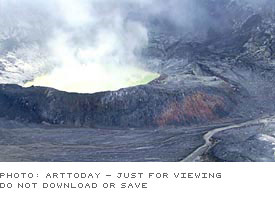|
In the crater of the Poas volcano, the absolute lack of vegetation suggests to us a moonlike landscape that contrasts with the sparkling green that carpets its sides. The Poas volcano is found in Costa Rica’s Central Volcanic Mountain Range, 57 km from San Jose and 37 km from Alajuela.
In 1971 a law was passed that created the Poas Volcano National Park, with an extension of 5,600 hectares. Its extraordinary scenic beauty has turned it into one of the most visited places in the region, despite the fact that it is still active, and that since 1989 the number of gas emissions and fumaroles has significantly increased. At its peak, 2,708 m high, is the main crater with a diameter of 1.5 km and very active fumaroles. At its center can be admired a lagoon, with tones that range from blue-sky to green. A second crater full of rain water gives origin to Botos lagoon, of exceptional beauty, that flows into the Caribbean through Angel river, a tributary of the Sarapiqui.
The park is home to four different types of habitats, almost concentric starting from the crater. First, an area without vegetation; then, an area of myrtles, the stunted forest, and finally the exuberance of the cloudy forest. Moss and ferns are omnipresent throughout the vegetation. Guneras also stand out: their leaves are the size of an umbrella. In the cloudy forest, trees--oak, cedar, white cypress--rise up to 20 meters, taller on the Caribbean side than on the Pacific slopes. Seventy-nine bird species have been identified within the limits of the Park, most with feathers of spectacular colors, among which stands out the mystic quetzal, on the verge of extinction. In the zoological catalogue stand out amphibians and reptiles. With respect to mammals, their presence is very discreet: coyotes, raccoons, weasels, rabbits, skunks and some felines. The ecological vocation of Costa Rican people has taken them to preserve many natural areas in their country, and the Poas Volcano National Park is an example of the benefits that this type of ecological politics can have on a community and on all of society.
There, nature is protected from man’s ravaging, for the benefit of man himself; an economic spill is the result of continually-growing tourism, that also creates jobs; also, geological, botanical and zoological education for children and adults is provided, with nature itself as an assistant. Education, recreation and protection, supported by an efficient infrastructure with asphalt-paved highways, watchtowers, a center for visitors and conferences, treks, exhibitions on points of interest and a net of qualified and friendly guides that give this gift of nature a Latin touch. Poas Volcano National Park, an example of the best of the latin spirit. |
|
|
 Can
a landscape with almost moonlike barrenness be surrounded by exuberant
vegetation?
Can
a landscape with almost moonlike barrenness be surrounded by exuberant
vegetation?